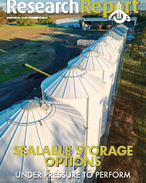This article is 1 year old. Images might not display.
It its October Crop Report, GIWA dropped its crop production estimate by around 550,000 tonnes (or three percent), compared to a month ago, to 14.95 million tonnes.
The yield potential has continued to slide over recent months with GIWA predicting in July WA would produce a 18.14mt tonne crop, before dropping the estimate to 16.96mt in August and 15.5mt in September.
GIWA's October WA production estimate for wheat dropped by 375,000t to a state total of 8.12mt, with barley down 105,000t to 3.84mt, canola down 40,000t to 2.22mt. It hasn't changed its oats and pulses estimates since September, which remain at 385,000t and 64,000t respectively, but dropped lupins by 30,000t to 320,000t.
"Harvesting is underway in the central and northern districts of the grain growing regions of Western Australia and is just starting further south in the state on early sown barley and canola crops," the GIWA said.
"Initial reports indicate the actual tonnage produced for Western Australia is going to be less than expected just prior to the start of harvest a few weeks ago.
"Persistent hot temperatures, combined with windy days and no further falls of rain, have driven grain yields down in all regions of the state.
"Most growers are reporting actual yields to be less than they looked when standing in the paddock."
Hot temperatures and lack of sub-soil moisture during the final stage of grain fill have taken their toll on WA crops, reducing potential grain yields and quality, with screening issues anticipated for many crops.
"The one-off low rainfall event in early September appears to have helped crops in the central region avoid very high screenings, although this is not the case in the majority of the northern regions," GIWA said.
Even though the estimated 15 million tonnes of grain for the state is well down on recent record-breaking years, GIWA said historically it is still a good result considering the lower area planted, the actual rainfall and the timing of the rainfall.
"On water use efficiency alone, total grain production would have been 30 percent less 10 years ago," it said.























